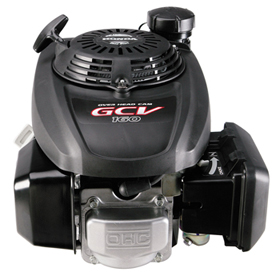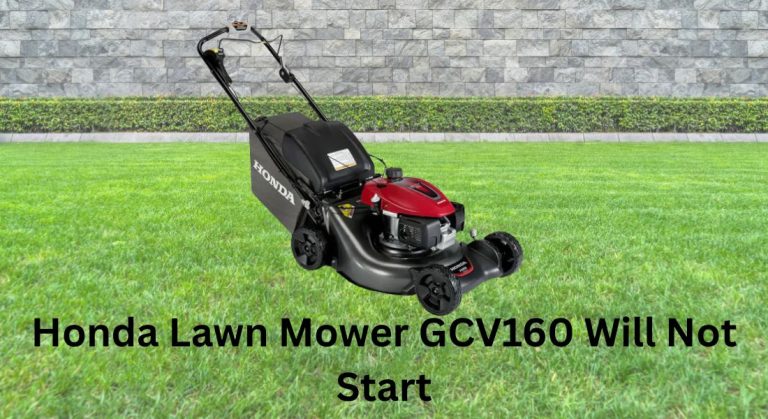It’s mowing day, but your Honda GCV160 won’t start—pull after pull, nothing. Whether it sputters once and dies or shows no signs of life at all, it’s frustrating. The quickest fix for many GCV160 no-start issues is to check the fuel shutoff valve (if equipped) and the choke position, then drain old fuel and replace the spark plug. Often, stale gas or a fouled plug is all that’s standing between you and a clean cut.
In this guide, you’ll get a complete troubleshooting plan to diagnose and fix a Honda GCV160 that won’t start. We’ll go through common causes, simple-to-advanced methods, safety tips, and prevention strategies. By the end, you’ll know exactly how to get your mower running and how to keep it starting on the first pull.
Common Causes of a Honda GCV160 Not Starting

- Stale or contaminated fuel (ethanol fuel older than 30–60 days)
- Incorrect choke or throttle position
- Fuel shutoff valve closed (on some models)
- Clogged carburetor jets or dirty float bowl
- Clogged air filter blocking airflow
- Fouled or damaged spark plug (NGK BPR5ES recommended)
- Safety switch not engaged (blade control/OPC lever not held, bail cable issue)
- Low oil level triggering engine protection
- Water in fuel from condensation
- Blocked fuel cap vent (creating a vacuum lock)
- Sheared flywheel key after blade impact (timing off)
- Clogged fuel line or fuel filter
- Faulty ignition coil (rare)
- Flooded engine from over-choking
How to Fix a Honda GCV160 That Won’t Start

Follow these methods in order—from fastest and easiest to more involved repairs.
Method 1: Quick Checks and Easy Fixes
Diagnosing the Issue
Before diving deep, confirm the basics. Many non-start issues are simple.
Fix Steps
- Confirm fuel and oil:
– Fuel: Ensure there’s fresh gasoline (E10 or less, 87+ octane). If fuel is older than 60 days, plan to drain it.
– Oil: Check dipstick. The GCV160 uses 10W-30. Low oil can cause hard starting and engine wear. - Set controls correctly:
– Move the choke to CHOKE/START position (or engage the auto-choke by starting the engine cold).
– Set throttle to FAST (rabbit icon), if equipped. - Check the blade control lever:
– Hold the Operator Presence Control (OPC) or bail lever firmly to the handle while pulling the starter. If the cable is loose, the engine brake may still be engaged. - Make sure the fuel valve is ON:
– Many Honda-powered mowers have a small lever under the tank. Set to ON (parallel to fuel line). - Inspect air filter:
– Remove the air filter cover. If the foam/paper filter is soaked with oil/dirt, remove it and try a start briefly without the filter to test airflow (do not mow without a filter). Replace if clogged. - Try starting with fresh fuel:
– If fuel is old, add a few ounces of fresh gasoline and try again. If it fires briefly, you likely have stale fuel or carb issues. - Check the gas cap vent:
– Loosen the gas cap slightly and try to start. If it starts with the cap loose, the cap vent may be clogged—replace the cap.
Testing
- If the engine starts and runs, replace the air filter if needed and tighten the gas cap.
- If it doesn’t start, move to fuel system cleaning.
Method 2: Fuel System Refresh (Drain Old Fuel and Clean Carb Bowl)
Stale or varnished fuel is the number one reason a GCV160 won’t start after storage.
Diagnosing the Issue
- Symptoms: No start after storage, occasional sputter, starts only with starting fluid (not recommended long-term), or runs briefly then dies.
Fix Steps
- Drain old fuel:
– Turn fuel valve OFF.
– Use a siphon pump to remove fuel from the tank into an approved container. - Clean sediment cup (if equipped):
– Under the fuel valve, some models have a clear sediment bowl. Remove it, clean the screen and bowl, reinstall with the O-ring, and turn valve OFF. - Remove carburetor bowl:
– Tools: 10 mm socket, pliers, carb cleaner, paper towels.
– Place a rag under the carb. Turn fuel valve OFF. Remove the bowl nut (often the main jet) and drop the bowl. Expect a bit of fuel. - Clean jets and passages:
– The bowl nut has tiny holes—these are jets. Spray carb cleaner through all holes until clear. Use a thin wire or bristle to clear varnish but don’t enlarge holes.
– Spray the emulsion tube/main jet in the carb throat (if accessible) and the float needle seat lightly. - Reassemble:
– Reinstall the bowl with the gasket seated correctly, tighten evenly. Turn fuel valve ON and check for leaks. - Refill with fresh fuel:
– Use fresh gasoline with a fuel stabilizer (optional but recommended).
Testing
- Prime by opening the choke and pulling the starter a few times. It should start within 3–5 pulls.
- If it starts and surges, proceed to an air filter and spark plug check. If it still won’t start, go to Method 3.
Method 3: Spark Plug and Ignition Check
A fouled or worn plug can prevent ignition.
Diagnosing the Issue
- Remove the spark plug wire. Use a 13/16″ plug socket to remove the plug. Look for:
- Black, sooty deposits (rich/flooded)
- Wet with fuel (flooded)
- White, blistered insulator (overheated)
- Cracked insulator (replace)
Recommended plug: NGK BPR5ES
Gap: 0.028″–0.031″ (0.7–0.8 mm)
Fix Steps
- Clean or replace plug:
– If mildly sooty, clean with a wire brush and regap. If worn/damaged, replace with a new NGK BPR5ES. - Check spark:
– Reconnect the plug wire, hold the plug threads against bare metal on the engine using insulated pliers. Pull starter and look for a strong blue spark. Warning: Keep away from fuel; do this in a well-ventilated area.
– No spark? Inspect the kill switch cable (OPC/bail lever) to ensure the brake/kill is releasing. A grounded kill wire will prevent spark. - Reinstall plug:
– Hand-thread, then tighten 1/8–1/4 turn past snug (or 13 ft-lb if using a torque wrench). Reattach the plug boot firmly.
Testing
- With fresh fuel and a good plug, most GCV160s start within a few pulls. If still no start, continue.
Method 4: Air, Fuel, and Choke System Fine-Tuning
If it still won’t start, refine the airflow and starting procedure.
Diagnosing the Issue
- Engine tries to start with choke closed but dies when open: clogged idle circuit.
- Engine won’t fire at all but has spark: insufficient fuel delivery.
Fix Steps
- Replace the air filter:
– Paper element: replace if dirty. Foam pre-filter: wash with soapy water, dry fully, lightly oil, and reinstall. - Verify choke operation:
– With the throttle/choke lever set to CHOKE, confirm the choke plate in the carb throat fully closes. If not, adjust the linkage or auto-choke thermostat (on auto-choke models) and ensure return springs are intact. - Check fuel line flow:
– Turn fuel valve ON, disconnect the fuel line at the carb (use pliers on clamp). Fuel should flow freely. If not, replace the fuel line and clean/replace the in-tank screen or sediment cup.
Testing
- Try starting again. If it runs only on choke or dies at idle, perform a deeper carb clean (Method 5).
Method 5: Full Carburetor Clean or Replacement
If varnish has plugged the idle and main circuits, a full clean is needed.
Diagnosing the Issue
- Starts with choke and dies when opened, surges, or won’t start after storage even after bowl cleaning.
Fix Steps
- Remove carburetor:
– Turn fuel valve OFF and remove air filter housing.
– Disconnect linkages and spring carefully (take photos for reassembly).
– Remove carb mounting nuts and slide off the carb, keeping the gasket(s). - Deep clean:
– Disassemble the carb: float, float pin, needle, jets, emulsion tube.
– Soak metal parts in carburetor cleaner (or ultrasonic cleaner) for 30–60 minutes.
– Blow out all passages with compressed air. Ensure all jets’ tiny holes are clear. - Inspect gaskets and O-rings:
– Replace bowl gasket and any torn intake gaskets. A vacuum leak can cause no-start/poor run. - Reinstall:
– Refit the carb, linkages, and springs as photographed. Ensure the choke and throttle move smoothly. - Consider replacement:
– Aftermarket GCV160 carb kits (with gaskets and primer/sediment cup) are inexpensive and often faster than cleaning. Use a model-specific replacement for your mower.
Testing
- Fill with fresh fuel, set choke, and pull. It should start and idle smoothly. Adjust idle speed screw if necessary according to the manual.
Method 6: Safety Interlocks, Compression, and Timing
If you still have no start with fuel and spark confirmed, inspect mechanical and safety systems.
Diagnosing the Issue
- No spark unless bail lever is held extremely tight: cable adjustment needed.
- Recoil feels unusually easy with little resistance: low compression or sheared flywheel key.
- Backfire through carb or pull cord jerks violently: timing issue (flywheel key).
Fix Steps
- OPC/bail cable adjustment:
– Locate the cable adjuster at the handle. Tighten until the engine brake fully releases when the lever is held. Verify the brake pad clears the flywheel. - Compression check (optional):
– Healthy GCV160 compression is typically 70–100+ psi on a pull-start engine (varies). Low compression may indicate valve issues or worn rings. - Check flywheel key:
– Remove the recoil shroud, hold the flywheel with a strap wrench, remove the flywheel nut, and inspect the key. If sheared or partially sheared, replace with a genuine Honda key and torque the nut to spec (typically around 36–43 ft-lb; check your model’s manual). - Ignition coil test:
– Confirm correct air gap between coil and flywheel magnet (about 0.010″–0.014″). Replace the coil if you still have no spark after kill switch isolation.
Testing
- Reassemble and test start. Correct timing and interlock function should restore starting.
How to Prevent Future Starting Issues
- Use fresh gas and add fuel stabilizer if storing more than 30 days.
- Run the engine dry or shut off the fuel valve and run until it dies before winter storage.
- Replace the air filter annually or as needed.
- Replace the spark plug every season or 100 hours.
- Drain and clean the carb bowl at the start of the season.
- Keep the deck and cooling fins clean to prevent overheating and varnish formation.
- Store the mower in a dry, covered area to avoid water contamination.
Pro Tips
- Use ethanol-free fuel (E0) if available—it stores better and reduces varnish.
- Mark your gas can with the purchase date; discard or repurpose fuel older than 60 days.
- When cleaning jets, a single strand of copper wire (from electrical wire) is gentle and won’t enlarge the jet.
- If the engine is flooded, open the throttle, turn the choke OFF, remove the plug, pull the cord 8–10 times to clear, reinstall plug, and retry.
- Keep spare parts on hand: NGK BPR5ES plug, air filter, bowl gasket, and carb kit.
- Photograph linkage and spring positions before disassembly to ensure correct reassembly.
- If the mower stalls when you tip it, always tip carburetor side up to avoid oil flooding the air filter.
When to Call a Professional
- You have spark and fresh fuel but zero combustion after a deep carb clean.
- Recoil cord jerks back violently, or you suspect a timing issue and aren’t comfortable removing the flywheel.
- Low compression diagnosed or persistent oil fouling of plug.
- Cracked carb body, stripped threads, or persistent fuel leaks.
- Cost-effective rule: If parts and your time exceed 50% of a comparable replacement mower, consider pro service or replacement.
Typical costs:
– Carburetor cleaning/service: $60–$120
– Carburetor replacement: $40–$90 parts + labor
– Ignition coil: $25–$60 parts
– Flywheel key replacement: $60–$120 labor-inclusive
Warranty:
– If your mower is still under warranty, avoid disassembly and contact an authorized Honda service center. Keep receipts and use approved parts to maintain coverage.
FAQ
Q: What spark plug does a Honda GCV160 use?
A: The GCV160 typically uses an NGK BPR5ES spark plug. Set the gap to 0.028″–0.031″ (0.7–0.8 mm). Replace yearly or every 100 hours for reliable starts.
Q: How do I know if my fuel is bad?
A: Old fuel smells sour/varnish-like and may appear darker. If the engine starts only with choke or starting fluid, or won’t start after storage, stale gas is likely. Drain and replace with fresh fuel.
Q: Why does my GCV160 start and then die?
A: Common causes include a clogged carburetor idle jet, blocked fuel cap vent, or a dirty air filter. Clean the carb bowl and jets, loosen the gas cap briefly to test the vent, and replace the air filter.
Q: Can a clogged air filter cause no-start?
A: Yes. A severely clogged air filter restricts air, making the mixture too rich to ignite. Replace or clean the filter and try again briefly without the filter to confirm airflow.
Q: How can I tell if the flywheel key is sheared?
A: Symptoms include hard kickback on the starter cord, backfires, or no-start after hitting a rock with the blade. Inspect by removing the flywheel; a partially sheared key shifts timing and prevents starting.
Q: Is using starter fluid safe on a GCV160?
A: It’s better to use carb cleaner sparingly in the carb throat. Starter fluid can wash oil from cylinder walls. If it starts only with spray, the carb needs cleaning.
Q: What oil should I use and can low oil prevent starting?
A: Use 10W-30 for most conditions. While the GCV160 doesn’t usually have a low-oil shutdown like some engines, running low can affect performance and starting, and risks engine damage.
Alternative Solutions
If repeated carb issues persist, consider alternatives:
| Solution | Pros | Cons | Best For |
|---|---|---|---|
| Replace carburetor with OEM/quality aftermarket | Fast fix, restores performance | Cost, slight tuning needed | Heavily varnished or corroded carbs |
| Switch to ethanol-free fuel + stabilizer | Better storage life, fewer clogs | Higher fuel cost, availability | Seasonal users storing fuel >60 days |
| Inline fuel filter addition | Extra debris protection | May restrict flow if not sized right | Mowers with tank sediment or rusty cans |
Get Your Honda GCV160 Working Again
Following this guide, you now have multiple solutions to fix your starting issues:
– Quick checks: fuel, choke, air filter, gas cap, and OPC cable
– Fuel system refresh: drain stale fuel, clean bowl and jets
– Ignition and air: new NGK BPR5ES plug, proper gap, fresh filter
– Deep repair: full carb clean/replacement, flywheel key, and coil checks
Don’t let a stubborn start ruin your mowing day. Work through these methods in order, and your Honda GCV160 should roar back to life—often with just fresh fuel and a cleaned carb.
Have you fixed your Honda lawn mower GCV160 that would not start? Share what worked in the comments to help other readers. Found this guide helpful? Bookmark it for future tune-ups and stress-free starts.





